GeneWeb cn.60
Aksionov, Savor & Lenc
GeneWeb cn.60
Aksionov, Savor & Lenc
Contents of this WebSite-1. Origins & History of Aksionov & Related Families
2. Ivan Dmitrich Aksionov: 'God Sees the Truth But Waits', by Leo Tolstoy, ca.1880§. Names Map- East European Connections60. Aksionov, Savor & Lenc
61. Aksionov of Vladimir & Stavropol§. Arms of Novgorod, Vladimir & Stavropol (Aksionov)62. Savor of Karlovac
§. Arms of Karlovac (Savor, later Aksionov)¶. History & Images of Karlovac
63. Lenc of Bavaria§. Arms of Lenc of Bavaria64. Poljakovic of Subotica
§. Arms of Slavonia & N-Romany (Baisic)§. Arms of Vojvodina (Poljakovic)65. Aksionov & Kuper: Yarra Valley
§. Arms of Subotica (Budinevic)
GeneWeb Pages Affiliated with this Site-Genealogy 01- Main Page (Index)...Genealogy 10- Newman of Wessex...
SEE- Link: 15. Campbell Newmans (Bellevue Hill & Gold Coast)Genealogy 61- Aksionov of Vladimir & Stavropol
1.
Origins & History -
Aksionov & Related Families
The origin of the name AKSIONOV is controversial. Some say it comes from the feminine word AKSENIA, meaning 'hospitable' (first found in literature in 1356). KSENIA was a Russian goddess of the hearth, identical with Roman VESTA and Greek HESTIA. Others hold that it is in fact identical with the name OKSENOV. This originally meant a man of Novgorod (1409), but later came to mean anyone who worked on the land (1613). By this time an AKSENTIEV was synonymous with 'peasant' (Wickenden, 2002), which perhaps explains why it is one of the most typical of all Russian names. Possibly all of the above are true, since the men of Novgorod were notoriously hospitable to strangers, and were proud of their farm labouring way of life. In English translation from Russian it is more usually spelt AKSYONOV. Aksionovs claim mythical descent from the hero Alexander NEVSKY.
The name is most common around Moscow and in the Far Eastern Pacific provinces. This distribution suggests two main divisions at a late date, and low mobility.
In any event, Ivan Dmitrich AKSIONOV (61) was a prosperous merchant who owned several shops in the City of Vladimir (§.i), a day's journey from Moscow. Nothing much would be known of him except for the lively interest of the great Russian writer TOLSTOY, who was for some years a journalist and observer of everyday human affairs. Born around the auspicious year 1775, in the reign of Empress Catherine II 'the Great', Ivan Aksionov was a free man of his city, unlike the vast bulk of the Russian populace who were tied to the master of the soil where they were born. An epoch of wealth and intrigue as Russia enlarged its Empire, this was a time of opportunity for free-born citizens, but also of danger for 'independent souls' living in an autocracy that feared revolution and treated its people with harsh suspicion.
Tolstoy (1828-1910), keen traveller and journalist, was born some fifty years later than Aksionov, and may have heard his story from others who had known him (see, God sees the truth, but waits, ca.1880, below). During the reign of Catherine's grandson Alexander I, and the instability of the Napoleonic Wars, a merchant from a neighbouring town hid a blood-stained knife in Aksionov's bag. Falsely charged with murdering a merchant from Ryazan, and of robbing him of twenty thousand rubles, he was condemned to be flogged and exiled. For twenty-six years he was a prisoner in the mines of Siberia, where he made boots and was known as 'The Saint' for his piety. Petitions to the czar organised by his wife and others failed, and confiscated goods and money were never recovered. Despite this setback, the Aksionov family in Vladimir prospered anew. Eventually the murderer himself confessed to Aksionov and to prison authorities, but the old man, despite being only 60 or so, refused to leave. One day he was ordered to be released, but was found already dead.
According to Vlado Aksionov (1992), successive generations of Aksionov have alternated between the names Dmitri and Vladimir. When commerce waned as a reliable livelihood under the nationalistic absolutism of the later Czars, the family came to live in the district of Stavropol, not far from the Caspian Sea, where they purchased a farm and returned to an earlier way of life governed by the seasons. This seems to have continued for some three generations before the Great War. As country families tended to be large, the name AKSYONOV remains common around Stavropol.
Revolution began in Russia in 1905 due to repressive rule, foreign wars, uncertain markets for Russian goods, and widespread famine. In 1914, Dmitri AKSIONOV (60), then aged 19 years, decided to enlist in the war - at least this was no worse than starving to death at home. He may have been in Palace Square, Moscow, on 1st August, when war was declared and ten thousand people gathered together to acclaim the Czar. 'Much moved, he blessed them: last fervent gesture of the last sovereign' (Olivier, 1979: 206). The Czarina's mentor, the monk Rasputin, was assassinated in 1916, and the army mutinied in February 1917, followed swiftly by abdication of the Czar in a railway carriage on 15 March, institution of Bolshevik (majority) rule, and finally by the assassination of the entire Romanov royal family at Ekaterinburg on 16 July 1918. Many Russian soldiers were stranded in central Europe at various 'fronts' when these events occured, and had few alternatives other than to wait out the entire course of the war wherever they could. Return to Russia was dangerous, and life there uncertain. Many never went back. Dmitri Aksionov found work at the brewery of Karlovac, in Yugoslavia, and stayed. During the next seven years, he met and married Dorothea SAVOR, daughter of the owner of the brewery.
SAVOR (62) is a very old name in the Karlovac region, but may have distant links to the German surname SCHAFFER. The name Tomica SAVOR is of great antiquity, and there has been at least one leading member of the family by that name for centuries (§.ii). Due to its close association with the Karlovac fortress against Ottoman invasion, the Savors used the first name Tomica or Tomislav after the early Slav hero-king who fought against the Turks, since the family is one of the several oldest in the town. Although the SAVORS were already a berger family, they rose to prominence when they acquired the brewery in the years leading up to the Great War. Even after the socialisation and nationalisation of industry, including the brewery, the Savors continued to prosper as technocrats under the communist government of Marshal Tito, with access to a summer house on the Adriatic Sea in Istria. A branch of the family emigrating to Florida in the United States continued the tradition of factory owning (VA, 1992).
The families of POLJAKOVIC (64) and BUDINEVIC (64-b) came from the Vojvodina wheat plain (§.iii) that lies between Hungary and Serbia. Maria BUDINEVIC, a peasant farm labourer, spoke Hungarian as her first language, and her family seems to have originated further north (§.iv). Stipan POLJAKOVIC, a soldier in the Austro-Hungarian army, was captured, tortured and murdered by the Russian Army during their successful advances in 1916. Though from a Serb family possibly originating in Belgrade, Stipan was Catholic with strong pro-Austrian sentiments. Before the Great War the couple lived in Hungarian-ruled Subotica, immortalised in Graham Greene's 'Stamboul Train' (1932), one of few stops on the Orient Express railway journey to Istanbul.
BAISIC (63-b) is a common name in Zagreb and Slavonia, but is probably of Romanian (Gypsy-) origin (§.v) (cf. 'Bashir'= gypsy or gypsy king). Christina was a favourite Romany name, and it is probable that Johann LENC met Christina BAISIC when on holiday in the hills of northern Slavonia, then a popular destination for Bavarian Germans exploring the Austrian hinterland. There is much debate as to whether the Romany gypsies were descended from Coptic Egyptians expelled from Cairo, a sect of Indians from Christian Goa, Moors from Cordoba, or the descendants of Italian centurions pensioned off by the legions to live in rural farmlets of Transylvania at the zenith of the Roman Empire. It is becoming increasingly clear that the Gypsy nation originated from Indo-Egyptian refugee ghettos in Damascus and Thrace, who eventually found a seasonal mountain homeland alongside Romanian peasants of antique Latin origin. Semi-nomadic, highly mobile due to affinity with horses, of striking appearance due to their unique heritage, they mixed with other refugee groups across the entire expanse of Europe, absorbing their rich folklore traditions and blending them with their own. These probably included, at an early date, some Moorish refugees from southern Spain.
LENC (63) is an ancient German name which
came to be applied to 'cobbler' in much the same way that BACH was applied
to 'musician', due to families of cobblers bearing the name. There
is a town of LENC in Bavaria (§.vi),
but some aristocratic VON LENC families originated further north.
§. Arms of Novgorod,
Vladimir & Stavropol
[Aksionov families] -
 Aksionov of Novgorod (859, 1781)
Aksionov of Novgorod (859, 1781)
This is the second most ancient shield in Russia after that of the town of Vladimir. Its first use is recorded in 859, when it consisted of two bears in the upper half, and two fish swimming towards each other in a blue margin. Instead of a candelabra there was a six pointed star. Since 'Oksenov' means a man of Novgorod, these are the oldest symbols associated with the name Aksyonov. The shield was instituted with minor amendments on August 27, 1781, by decree of Empress Catherine II 'the Great', and reinstated on September 12, 1991 by decision of the Novgorod City Soviet of People's Deputies.
The oldest known coat of arms in its original form in Russian heraldry,
these arms were continuously used over the centuries as the seal of the
Town of Vladimir, viz. the head of a lion crowned with a cross in its paws.
The lion is the emblem of the hero Yuri Dolgoruky, from the mid 12th century.
The Aksionovs were probably originally settled in Moscow with many other
men of Novgorod, before coming to Vladimir as free merchants. Some
time later, in the oppressive reign of Nicholas I (1825-55), they moved
to Stavropol, where they remained for 3 generations.
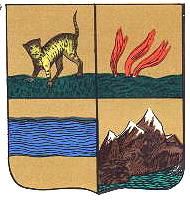 Aksionov et al. of Stavropol (c.1848)
Aksionov et al. of Stavropol (c.1848)
Arms of Caspian Sea Province (now the District of Stavropol), up to
1917. The Aksionov farm (for 3 or 4 generations) was somewhere between
Stavropol and the western shores. A series of bread famines culminated
in the Great Famine of 1917, when the arms of the Imperial Caspian Province
were replaced. The name Aksyonov is still common in the surrounding
district.
61. Aksionov of
Vladimir & Stavropol
| I |
b.ca.1775, Vladimir (nr.Moscow) Merchant; m. ca.1800, owned houses & shops afterwards prisoner in mines of Siberia d. there ca.1835, aged ca 60 yrs [pardoned & exonerated by Tsar] |
[Tolstoy wrote a short
account of his captivity, see History, above] |
| II |
fl. ca. 1825 |
[merchant
of Vladimir] |
| III |
b. Vladimir, ca.1825; d. Stavropol, Caucas |
[farmer] |
| IV |
b. ca.1850 (eldest son of eldest son) d. Stavropol, Caucas |
[farmer] |
| V |
b.ca.1875 Stavropol District, nr.Caspian Sea = Olga, fr. Ural Mts., W-Siberia |
[farmer] |
| VI |
b.ca.1895, Stavropol [eldest child] d.1970, Karlovac, Yugoslavia, 75 yrs = Dorothea SAVOR, of Karlovac |
[soldier, Russian Army WW-1;
brewery worker; kn. as 'Little Deda'; 4'11", had 2 brothers over 6'] |
| VII |
b. 1 Dec.1926, Karlovac, Yugoslavia [eldest son; held Russian passport] = Julijana LENC, of Zagreb, Croatia [Yugoslavia] |
[cabinet maker;
partisan, Tito's army WW-2; 'Deda'] |
| VIII |
b. 24 Apr.1960, Melbourne, Victoria [3rd of 4 daurs] = Campbell NEWMAN, of Bellevue Hill, N.S.W. |
[art teacher] |
| IX |
of Mt.Toolebewong, Victoria & of Ashmore, Gold Coast, Qld. |
[b. 11 Mar.1989,
20 Jan.1991, 27 Dec.1991] |
§. Arms of
Karlovac [Savor families] -
 Savor et al. of Karlovac (1579)
Savor et al. of Karlovac (1579) 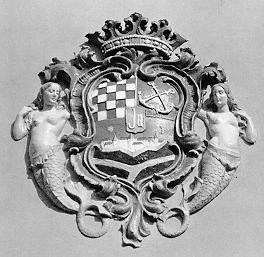
'Where the Dinaric Alps sweep down to meet the Pannonian plain is the town of Karlovac. Here, on the left bank of the Kupa, the great Pannonian plain ends, and a mountain region extends to the Mediterranean Sea. Karlovac is at an ancient crossroads, between Dalmatia and Croatia, presiding over the only mountain road to the coast. Although it remains a cross-roads for rail and road traffic, 56 km from Zagreb, 130 km from Rijeka, 30 km from Metlika in Slovenia, and 40 km from Velika Kladus'a in Bosnia and Herzegovina, Karlovac is still a county town, its population according to the census of 1991 being only 60,000. It is also the administrative centre of the region that embraces the Kupa area, the western part of Z'umberak, Kordun, parts of Lika and Gorski Kotar.
'Karlovac is the youngest city in the Republic of Croatia. It was founded in consequence of a military and political decision of 1578, when the Austrian Empire, and indeed western Europe as a whole, had to be defended against waves of Turkish invasions. Karlovac is, then, one of those few cities that developed from the drawing board. The precise place where the principal fortress for the defence of Croatia and Carniola was to be built was chosen by the Archduke of' Styria, Commander in Chief of the Military Frontier, Karlo of Habsburg. It was from him that the city derived its name: Karlovac, also known as Karlstadt, and Carolstadium. The building of the fortress ('Festung Karlstadt') began on July 13, 1579. By the following year it was fully garrisoned, with inhabitants subsequently coming in from outlying villages threatened by the Turks.
'Only fourteen years after the fort was constructed, the Ottoman forces
suffered a decisive defeat near Sisak (1593). Nearly a century later came
another more important defeat at Vienna (1683), and by 1718 the political
and military balance of power in this part of Europe had undergone profound
change. Karlovac lost its role as a military fortress and became a commercial
city. Thanks to its position, it became an important trading centre for
South East Europe, handling much of the trade that went on between Hungary
and the northern Adriatic. Indeed, the period from 1718 to the building
of the Zagreb-Rijeka railway line in 1873 was a golden age for the city.
It created an economic base that enabled the middle classes of Karlovac
to play an important role in the political and cultural life of Croatia.
International economic, political and military turmoil within the Habsburg
Empire led to instability, depression and decline in the years to the end
of the First World War. These were years of migrations and immigrants,
establishing links between many East European nationalities. During
this period a small enclave of emigrants [incl. SAVORS*]
located itself in Louisiana in the United States, whilst newcomers to Karlovac
included refugees from the Russian famine [incl. AKSIONOVS*]
who replaced some of the older families who had left.

The FORTRESS OF KARLOVAC.
See:
GeneWeb Page (62): Savor & Aksionov of Karlovac...
§. Arms of Vojvodina
(Poljakovic)
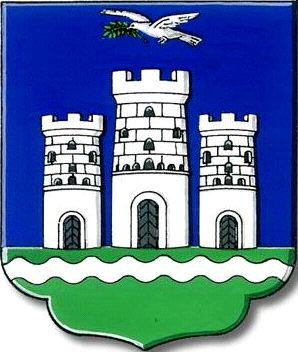 Poljakovic et al. of Vojvodina (1748)
Poljakovic et al. of Vojvodina (1748)
The wavy line represents the Danube River, whilst the castle symbolises the city of Vojvodina, Novi Sad.
§. Arms of Subotica
(Budinevic)
§. Arms of Slavonia
& Romany (Baisic)
 Kingdom of Slavonia, c.1250, 1496 (Baisic)
Kingdom of Slavonia, c.1250, 1496 (Baisic)
Now part of Croatia, the Kingdom of Slavonia was a title created and
used by the Hungarian Kings in the 13th century. Hungarian possession of
Slavonia was later heavily disputed. In the mid 18th century the
territory again passed to Austria-Hungary. This coat of arms dates
from 12th century coins, issued by King Emerich, and showed a marten between
two stars. In 1496 King Wladislaw II created these arms, 'a marten
between the rivers Drava and Sava'.
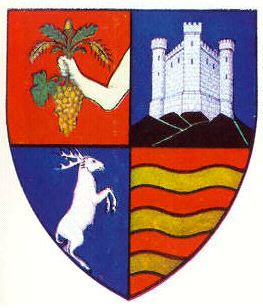 Bashi et al. of Salaj, Transylvania (1445)
Bashi et al. of Salaj, Transylvania (1445)
In 1445 several hundred thousand Romany were sent to Transylvania as slaves or 'Vlach' by the infamous Prince Vlad Dracul of Wallachia. Here they worked as tinkers, dancers, entertainers & horsetrainers, especially in the north-eastern province of Salaj [above left]. The enduring gypsy emblem, the 24-spoked wheel of fortune, is taken from the Indian 'chakra' [above right]. A great number of Vlach escaped to Slavonia, where the name Bashi signified 'Gypsy tribes' or 'of the Gypsies', or was sometimes a shortening of Bulibashan ('chief of the tribe'). These itinerants were musicians who played at village weddings, preserving the tradition of the 'Luri' of India. Their music influenced Joseph Haydn, whose family was Slavonian.
65. Aksionov
& Kuper of Yarra Valley
(Victoria, Australia)
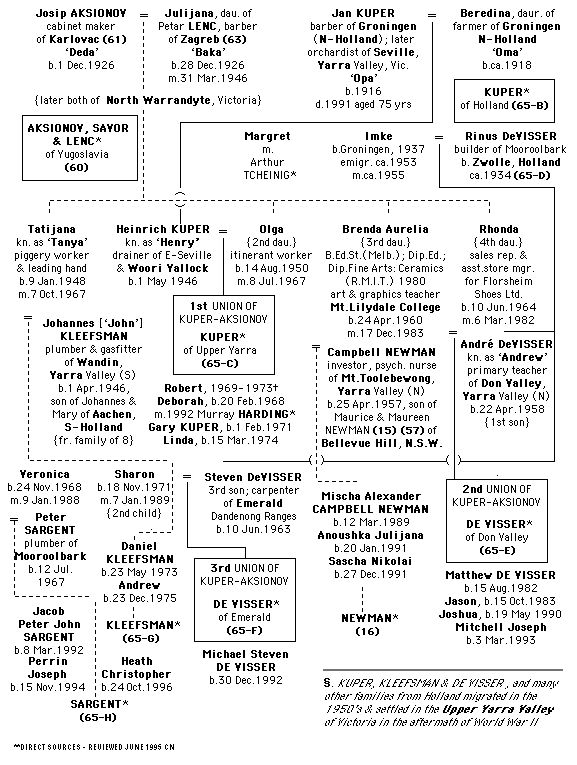
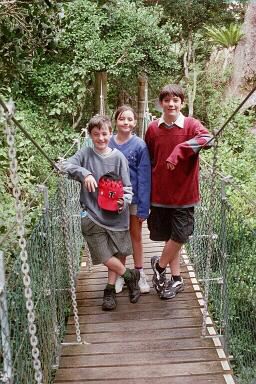
Sascha, Anoushka & Mischa (April, 2001) at O'Reilly's, Gold Coast
hinterland (Qld, Australia)